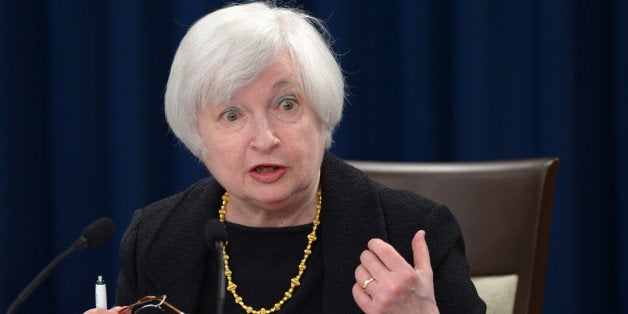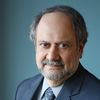
Barely a week after Fed Chair Janet Yellen cheered her many admirers by fending off pressures to raise interest rates in a weak recovery, Yellen reversed course. In a long, dense, technical lecture at the University of Massachusetts at Amherst on Thursday, Yellen concluded by indicating that the Fed is likely to raise rates by the end of 2015 after all.
So what's at work here? Obviously, economic conditions did not change between September 17 and September 24. Workers' wages continue to be flat, despite a gradual reduction in the official unemployment rate. The inflation rate continues to be well below the Fed's official target of 2 percent, with indications that it will go lower. Economic conditions outside the United States continued to be soft and getting softer in Europe, China, and much of South America, suggesting a drag on growth.
Why, then, does it make sense not to raise rates in September but to hike them in December, when a rate increase three months from now is just as likely to slow the recovery?
Has Yellen herself become more of an inflation hawk -- or is she just trying to reassure money markets and mollify her own colleagues at the Fed, most of whom are more hawkish than she is?
A careful reading of the speech suggests that Yellen doesn't entirely believe her own posture. What's much more likely is that the strong vote on September 17, in which the Fed's policy-setting Federal Open Market Committee (FOMC) voted 9 to 1 against raising rates now, was part of a tacit agreement to raise them after a decent interval. More on that in a moment.
The story told by the inflation hawks makes no sense, and Yellen has argued against it in other speeches and testimony. Low interest rates in a weak economy have not triggered inflation, and there are no signs that inflation will break out any time soon. The idea, promoted in some circles, that we need to raise rates now in case we need to cut them later, is equally silly.
I asked one former senior Fed official, who is a big fan of Yellen, what he thought she was up to. He said that markets had "priced in" the expectation of a rate hike, and the Fed needed to deliver. In other words, continuing to keep interest rates low might rattle the bond market.
But -- so what? The Fed, famously, is prone to "take away the punch bowl" when times are too good for regular people. Why not take away the bond market's punch bowl when money markets are not behaving in the public interest? The Fed's job is to counteract perverse trends in the private market, not to pander to them.
Paul Krugman recently noted the oddity of bank stock prices falling after the Fed's announcement September 17 that it was not raising rates, and suggested that a lot of the pressure for a rate hike comes from the banking industry, which makes more money when rates are higher.
Bottom line: The Fed talks technical economics, but it is an intensely political institution (surprise, surprise.) Because the Fed is so close to the financial industry, most of the chatter at the Fed is heavily influenced by bankers and bond traders.
Yellen, who began as a labor economist, of all things, is very much the exception. She has worked hard to place concerns for unemployment and wages on an equal footing with concerns about inflation, as required by the Humphrey-Hawkins Full Employment and Balanced Growth Act of 1978 -- a "dual mandate" that has been largely ignored by previous Fed governors.
But precisely because her views are so refreshingly atypical, Yellen has to take special care to keep a working majority on the Federal Open Market Committee, the group of other Fed governors and a sample of regional Fed bank presidents that actually makes policy. Though Yellen gets most of the attention, interest rate policy is set by majority vote.
The Chair has substantial influence, but in the past when a chairman faced a revolt, he (and all Yellen's predecessors were he's) typically switched sides or brokered a compromise so as not to be outvoted.
Yellen's UMass Amherst speech has all the telltale signs of doing what you need to do to keep a working majority. Obviously, the speech had been gestating for a while -- it was not written in a few days. The speech itself carefully assessed inflationary pressures and the lack of them. The ending almost seemed expediently tacked on.
The FOMC vote September 17 not to raise rates was too good to be true. The vote was 9 to 1, with only the obsessively hawkish Jeffrey Lacker, president of the Richmond Fed, voting to immediately raise rates.
However, several of the eight other committee members who voted with Yellen want a rate hike. The most important of these is the Fed vice-chair, Stanley Fischer, a far more orthodox central banker. Yellen and Fischer need to present a united front.
So the vote not to raise rates now, followed by a signal by Yellen herself that rates would be raised by year-end, is almost surely a tacit or explicit deal. If Yellen had not agreed to an eventual hike, she might have faced a revolt of the other members of the committee that she chairs.
The Fed Board of Governors has grown somewhat more orthodox in the past year. It lost the immensely talented and progressive Sarah Bloom Raskin, who was persuaded by the White House and Treasury Secretary Jack Lew to leave the Fed to become number two at Treasury. This may have been the most unfortunate lateral move of a key policy player since LBJ talked Arthur Goldberg into quitting the Supreme Court to move to the UN.
Raskin's successor, Lael Brainerd, though not an inflation-hawk, is far less progressive. And some of the Fed's most effectives doves, such regional Fed bank presidents Eric Rosengren of Boston and Narayana Kocherlakota of Minneapolis, are not currently on the policy-setting Federal Open Market Committee.
One other key item to keep in mind: There is in fact one source of "overheating" in the economy, but it isn't wages or consumer prices. Rather, it is the price increases in assets such as real estate -- the flip-side of the very low interest rates, as well as merger and acquisition activity and new forms of derivatives. Some economists have warned of another round of asset price bubbles.
Yellen herself has long recognized that the sweet spot of Fed policy is low interest rates to energize the real economy combined with tight regulation of purely financial speculation so that the cheap borrowing costs that the real economy needs to not fuel purely financial bubbles. She said as much in an important speech at the IMF, July 2014, arguing that monetary policy could not do everything and needed to be complemented by regulatory policy.
However if the Fed chair does not control the Federal Open Market Committee, even less does she control the Fed's senior permanent staff, which is dead set against Fed regulators telling bankers which classes of assets not to finance, or to finance at higher rates.
So where, exactly, does this leave things?
In her Umass Amherst Thursday speech, Yellen admitted, "Some slack remains in labor markets, and the effects of this slack and the influence of lower energy prices and past dollar appreciation have been significant factors keeping inflation below our goal." She added. "But I expect that inflation will return to two percent over the next few years as the temporary factors weighing on inflation wane."
Yet key economic indicators suggest that inflation is more likely to fall in the next couple of years than to rise. The bigger concern is deflation.
Several progressive economists, such as Jared Bernstein and Dean Baker, make the point that the Fed's two percent target itself is too restrictive and that if we ever expect wages to rise, the target should be more like three percent or four percent.
A Wall Street Journal account of Yellen's Thursday speech said she was "setting out to build a case [for a rate hike] like a prosecutor giving a closing argument." But the speech was anything but. With its even-handed analysis, she might just have easily have closed by concluding that no rate increase was necessary. The conclusion seemed to be motivated purely by FOMC politics.
In the Thursday speech, Yellen did leave herself the usual out. In the closing line, she said:
Most FOMC participants, including myself, currently anticipate that achieving these conditions will likely entail an initial increase in the federal funds rate later this year, followed by a gradual pace of tightening thereafter. But if the economy surprises us, our judgments about appropriate monetary policy will change.
In other words, if wages do not magically levitate and inflationary signs do not appear (both unlikely, as Yellen knows better than anybody), all bets are off.
So, no, Yellen has not gone over to the dark side. Rather, she is doing subtle battle against a deep structural tilt at the Fed, one that favors bankers and excessive price stability at the expense of the health of the real economy.
Robert Kuttner is co-editor of The American Prospect and professor at Brandeis University's Heller School. His latest book is Debtors' Prison: The Politics of Austerity Versus Possibility.
Like Robert Kuttner on Facebook.
Follow Robert Kuttner on Twitter.
